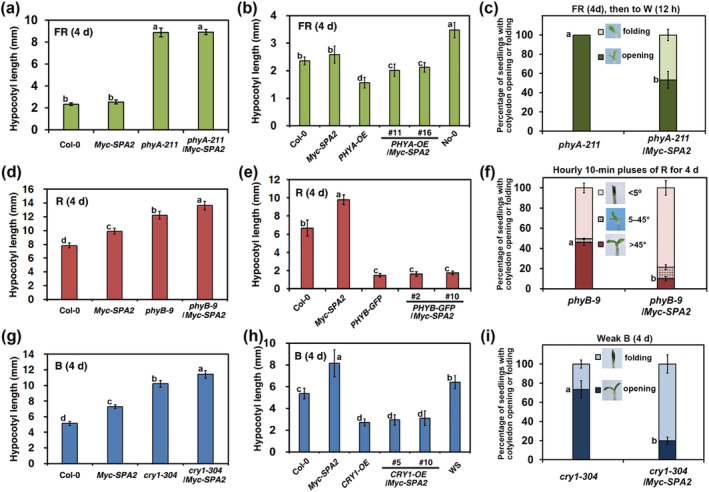FIGURE 6.

PhyA, phyB, and cry1 suppress SPA2 activities under far‐red (FR), red (R), and blue (B) light conditions. The fluence rates of the FR, R, B, or W were 1.9, 24.4, 11.6, or 7.8 μmol·m−2·s−1, respectively, unless otherwise indicated. Quantification of hypocotyl lengths (average of at least 30 seedlings) of the wild type (Col‐0), Myc–SPA2 (parental line #33), (a) phyA‐211 and phyA‐211/Myc–SPA2; (d) phyB‐9 and phyB‐9/Myc–SPA2; (g) cry1‐304 and cry1‐304/Myc–SPA2; (b) No‐0, PHYA–OE (No‐0 background, parental line, Boylan & Quail, 1991), and PHYA‐OE/Myc–SPA2 (lines 1 and 16); (e) PHYB–GFP (parental line, Zheng et al., 2013), and PHYB–GFP/Myc–SPA2 (lines 2 and 10); (h) CRY1–OE (parental line, Ahmad et al., 1998) and CRY1–OE/Myc–SPA2 (lines 5 and 10) under FR (a, b), R (d, e), or B (g, h) light condition for 4 days, respectively. Morphology and percentage of seedlings with cotyledon opening (c) phyA‐211 and phyA‐211/Myc–SPA2; (f) phyB‐9 and phyB‐9/Myc–SPA2; (i) cry1‐304 and cry1‐304/Myc–SPA2. Seedlings were grown (c) in FR light for 4 days and subsequently transferred to white light for 12 h; (f) in hourly 10‐min pluses of R light for 4 days; (i) in B weak light (0.17 μmol·m−2·s−1) for 4 days. Bars stand for standard deviations
